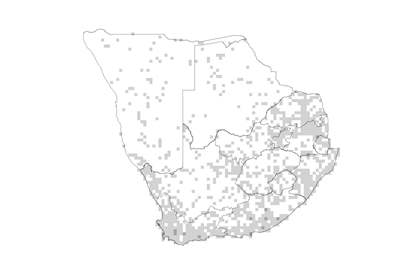 Species distribution and density. Darker squares represent higher density of members of this family. |
Introduction
Asparagus family
A small family consisting of a single genus of perennials with thick underground organs, reduced leaves and small, star-like, fragrant flowers.
Distribution
Widely distributed throughout Africa, Europe and Asia, with a single species in Australia. Most species are found in semi-arid to arid areas, but also found in Mediterranean climate; widespread in southern Africa.
Number of genera in the world
1
Number of species in the world
ca. 120
Number of genera in the Flora of southern Africa region
1
Number of species in the Flora of southern Africa region
88
Well-known southern African genera
Asparagus
Growth forms
Spiny shrubs, suffrutices or scramblers with stems arising from rhizomes, or rarely tubers.
Habitats
From exposed habitats on coastal plains to semi-shaded areas along forest margins; also in rocky areas in grassland and as climbers in forest.
Flagship species
Asparagus densiflorus (cat's tail fern; katstert [A]; isiqobola [Z]) is a well-known garden plant all over South Africa. It is an erect to scrambling shrublet, naturally found in woodland areas. Several cultivars have been registered by plant growers. This species can easily be grown from seed or by dividing the clumps. It grows relatively fast and prefers sunny to partially shaded areas. The red berries attract birds to the garden. (Photo: GN)
Significance of the family
The garden asparagus (A. officinalis) has been cultivated since ancient Greek times as a vegetable. Several indigenous species are known to be edible (A. africanus, A. capensis). Some species (A. setaceus, A. falcatus) are used by florists as foliage. Certain members of this group are also known as garden plants (A. asparagoides, A. densiflorus) and used in traditional medicine to treat kidney and stomach complaints, coughs and tuberculosis.
Diagnostic characters
Compact woody base with fibrous or tuberous roots . Leaves scale-like �, spurred at the base and subtending leaf-like phylloclades/cladodes �. Flowers star-like, regular, usually white or cream and fragrant, with 2 whorls of 3 tepals each and 2 whorls of 3 stamens each . Ovary superior � with 3 locules. Fruit a fleshy berry or occasionally a nutlet.
Did you know?
Asparagus falcatus is sometimes mistaken for young plants of the common yellowwood (Podocarpus falcatus).